The Rocking Chair Revolution ~ The History of Ordinary Things

The words ‘rocking chair’ appeared in the Oxford English Dictionary in 1787. Benjamin Franklin was credited with the invention in 1710, but probably early American cabinetmakers or farmers are responsible.
Historians believe the first armless rockers were designed to allow enslaved mothers to rock, or nurse, their babies while doing other chores, like shucking peas, darning socks and sewing. Prior to the rocker, women stood swaying side to side with their children in their arms, unable to get any other work done! The rockers allowed women to use their legs and back to create the rocking motion, thus rendering them hands free. As utilitarian chairs, they were usually simple, made from pine and were used outdoors.
Rockers progressed to full size with arms for the comfort of the aged and infirm. Rocking chairs moved from the fields to the front porch where men would tend to relax. The rocking relieved aches and produced a calming movement for farmers and others doing heavy physical labor. Rocking chairs were comfortable, reasonably inexpensive and readily available. By the early 1800s, most American homes had at least one on the front porch where families sat to enjoy the view and greet the neighbors. The padded, upholstered seats and back were added when the rocker moved into the house.
The rocking chair is strictly an American design. The first rocking chair concept was created in 1725 with skates tied to the bottom of an American Windsor chair. The Shaker rocking chair was invented in New York in 1820. The Boston rocking chair arrived in 1825. The wicker and bentwood rocking chairs were introduced in 1860. Platform rockers,1876, have seats that rock while the base remains stationary. Springs allow the movement. In 1880, Thonet patented a bentwood rocking chair with caned seat and back. By 1888, the glider rocker with a fixed base and a mechanical gliding seat was introduced. The Adirondack Rocker debuted in 1904 followed by the Mission rocking chair in 1905.
A woman’s rocker was held over from the past now for sewing or needlework. It is smaller, armless and typically has a drawer under the seat to hold sewing spools and other small items.
According to The New York Times, the rocking chair, “is the most American of all furniture forms, and has been a favorite of statesmen since the 18th century. Benjamin Franklin added metal bends to the base of his outsized library chair to make it rock, and Abraham Lincoln was assassinated while sitting in a Victorian rocker that had been installed at Ford Theater especially for him that night.” It is known as the Lincoln Rocker.
In 1955, due to back pain from a military injury, John F. Kennedy’s physician recommended a rocking chair. Known as the Kennedy Rocker, this Appalachian style rocker soon became a feature of many American homes. Jimmy Carter and Ronald Reagan owned Maloof rockers (Sam Maloof, designer).
The rocking chair aids in calming the body and mind. Under stress, the body naturally engages in a rocking motion to self-soothe. The movement creates a sense of nostalgia and relief. The rocking motion releases endorphins in the brain which can improve one’s mood and reduce anxiety and tension.
Maybe we all should spend a little more time in a rocking chair!
- Rain & Shine, A Millennia Of Innovation: The History of Ordinary Things - July 19, 2024
- Crayons Through The Ages ~ The History of Ordinary Things - June 21, 2024
- The Rocking Chair Revolution ~ The History of Ordinary Things - May 24, 2024


